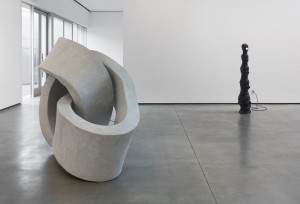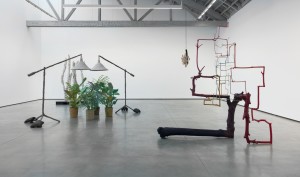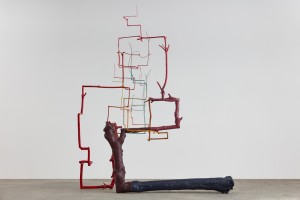Charting a path through Evan Holloway’s large floor-based sculptures at David Kordansky Gallery is like walking through a forest that has undergone a transformation into ever-lasting materials that are the antithesis of nature —bronze, steel, resin, plaster and fiberglass. These simultaneously solid, yet fragile works form infinite loops like the Möbius strip-shaped Benzoin, (2015); a giant knot turned in on itself that begs to be viewed from multiple vantage points. The whiff of a burning incense stick follows viewers as they encircle the work. It’s an uncanny juxtaposition— the natural essence with the fabricated form.

Evan Holloway, Installation view, courtesy of the artist and David Kordansky.
Holloway’s works are socially and politically astute while also taking on formal concerns. His use of materials is exacting and specific. Often, the functionality of a natural or man-made form (branches, batteries, light bulbs) is stifled or rendered useless. At the same time, he manages to transform these pedestrian/common things into aesthetic objects.

Evan Holloway, Installation view, courtesy of the artist and David Kordansky.
Serpent and Lightning (2016) is Holloway’s latest addition to an ongoing series of tree-branch sculptures. In this work, an intricate assemblage of painted, cast bronze branches is organized into a lattice of interlocking rectangles that become smaller and more delicate as they move from the floor toward the ceiling.

Evan Holloway, Serpent and Lightning (2016), courtesy of the artist and David Kordansky.
Plants and Lamps (2015) furthers Holloway’s exploration of fabricated nature. In this work, Holloway has created two mixed-media, large soft box lamps (like those used in a photography studio) and positioned them over four recreations of household potted plants. These objects never need to be watered, nor do they need light. Again and again, Holloway fabricates functional objects, then takes them out of context and renders them useless. This idea also applies to Landscape (2015), a work that comments on energy and waste. Hundreds of spent batteries cover elongated, pod-like white plaster forms, becoming colorful buds on Holloway’s inert trees.

Evan Holloway, Plants and Lamps (2015), courtesy of the artist and David Kordansky.
Holloway regenerates his own ideas as easily as he recycles materials, though in each new iteration of a work, something original occurs. While certain elements in these pieces have been seen before—stacked heads with light bulb noses, bronzed branches, batteries piercing plaster—the works continue to be rigorous explorations of that place where form and content meet.
Evan Holloway, January 30 – March 26, 2016 at David Kordansky Gallery, 5130 W. Edgewood Place, Los Angeles, CA 90019, http://davidkordanskygallery.com.


